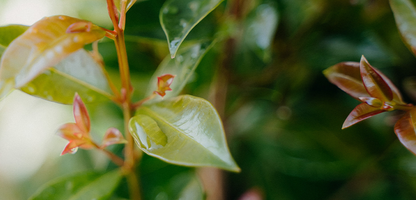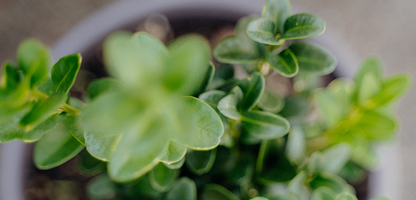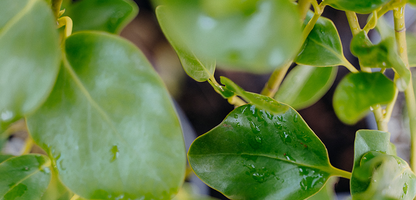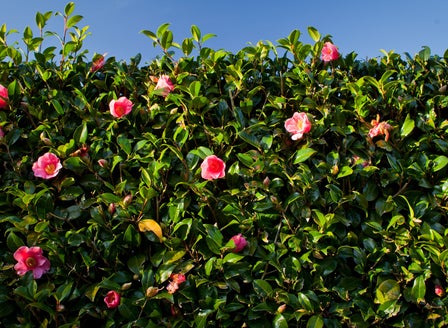Hedging plants are great at creating privacy from a road or the neighbours, or to section off parts of the garden. They come in different sizes, and can even be shaped into topiary!
Planting Calendar
Hedging plants can be planted throughout the year but do better when planted in Spring and Autumn, giving it time to establish its roots before the heat of summer.
Prepare
Before buying your plants it's important to know what type of hedge you want. Are you after low growing and formal plants, or maybe something a bit taller? Do you need them to be quick growing? How many plants you will need will also depend on what type of hedge you are planting.
Position
The distances stated in this guide are designed for an average garden with the hope of achieving an established hedge in a reasonable amount of time. The results from planting them closer will mean you will achieve an established hedge faster and the opposite results if you were to plant them further apart.
Soil
When planted into the ground hedging plants like a free draining soil that is rich in organic matter. To improve the organic content in your soil, break up the soil and add Kings Compost and Kings Sheep Pellets then mix together well. When growing in containers, plant into Kings Container mix. This mix contains added water storage crystals and Saturaid, two products that help maintain moisture in the soil.
Plant
When planting into the ground, gently tap the plant out of its pot. Dig a hole twice the depth and width of the plants root ball. Mix Kings Compost into your existing soil at a 50/50 ratio, add Sheep Pellets and Kings 24 Plus Fertiliser, then mix together well. Back fill the hole with this soil, so that when planted the top of the plant’s roots sit level with the surrounding ground. Firm the soil down gently and water in well with Aquaticus Organic Garden Booster. In heavier clay soils, where drainage is likely to be an issue, plant onto a raised mound and sprinkle Gypsum Clay Breaker into the bottom of the hole, this helps slowly condition the soil and help to break down the clay. When positioning your plants, look at how the plant is already growing. Plant the bushier sides facing across from the next plant, as this will ensure your hedge fills in quicker. When planting into containers plant into Kings Containers mix, as this has water retention crystals in it, which will help in keeping the soil moist. Firm the soil down gently and water in well with Aquaticus Organic Garden Booster.
Care
Watering
Watering is essential especially in the first year of planting to allow the roots to get well established. Water slowly allowing the water to sink down into the roots, rather than allowing it to run off the top of the soils surface. Add Saturaid into the soil at planting as this will help channel the water deep down into the root zone. Consider setting up an automatic watering system – these can be simple and inexpensive.
Feeding
When planted in the ground liquid feed every month with Aquaticus Garden Booster, from Spring through to the end of Autumn, this encourages root growth and increases the microbial activity in the soil. Monthly applications of Kings Sheep Pellets will help with soil conditioning and plant health. If planted into a container, feed with Kings Liquid Fast Food along with monthly applications of Aquaticus Organic Garden Booster this encourages strong roots and a healthy immune system.
Mulching
Mulch around the base of the plants (make sure that the mulch does not come into direct contact with the stem of the plant) with Living Earth More than Mulch. Mulching helps to reduce weeds as well as aiding the soil to retain moisture.
Pruning
Regular pruning is essential if you want to create a dense, well-structured hedge. Prune after each flush of new growth. Ensure that you use sharp tools to avoid brown jagged edges on the leaves
General Care
When using sprays, chemicals or fertilisers always read the label and follow the instructions. Apply sprays in the evening to avoid harming beneficial insects.
Expert Tip
Regular pruning is essential if you want to create a dense, well-structured hedge. Prune after each flush of new growth. Ensure that you use sharp tools to avoid brown jagged edges on the leaves
Top Varieties

Eugenia ventenatii
Eugenia ventenatii is a tall hedge. A new form of the old “Lily Pily”, favoured for its speed of growth, bushy-ness and interesting foliage. Foliage: Oval/pointed leaves 50mm long, new foliage starts off as a crimson red and fades to a dark green. Very dense. Height: 1.5-3m. Speed of growth: Very fast. Planting distance: 0.75m.

Buxus sempervirens
Buxus sempervirens is a small hedge, traditionally used in formal gardens to define the edges of garden beds or line either side of a path or walkway. Foliage: Dark green, 15mm long and very dense. Height: 0.2-1.5m. Speed of growth: Slow-medium. Planting Distance: 20cm.

Griselinia Broadway Mint
Griselinia Broadway Mint is a tall hedge, incredibly popular with its vibrant green foliage and its ability to form a dense hedge. Great for screening and creating privacy. Foliage: Large, rounded leaves, 80-100mm long, bright green and highly glossy. Prune regularly to keep dense. Height: 1-2.5m. Speed of growth: Medium. Planting distance: 0.75m.
Frequently Asked Questions
How do I choose the best hedging plants for my garden?
Consider factors like sunlight, soil type, desired height, and maintenance level. Popular choices in Auckland include Pittosporum, Buxus, and Griselinia.
What is the best time to plant a hedge?
The ideal time to plant hedges is in early autumn or spring when the soil is warm and moist, ensuring good root establishment before winter or summer.
How often should I water my newly planted hedge?
Watering is essential especially in the first year of planting to allow the roots to get well established. Water slowly allowing the water to sink down into the roots, rather than allowing it to run off the top of the soils surface. Add Saturaid into the soil at planting as this will help channel the water deep down into the root zone. Consider setting up an automatic watering system – these can be simple and inexpensive.
What type of soil is best for hedging plants?
When planted into the ground hedging plants like a free draining soil that is rich in organic matter. To improve the organic content in your soil, break up the soil and add Kings Compost and Kings Sheep Pellets then mix together well. When growing in containers, plant into Kings Container mix. This mix contains added water storage crystals and Saturaid, two products that help maintain moisture in the soil.
How can I maintain the shape and health of my hedge?
Regular pruning is essential if you want to create a dense, well-structured hedge. Prune after each flush of new growth. Ensure that you use sharp tools to avoid brown jagged edges on the leaves
